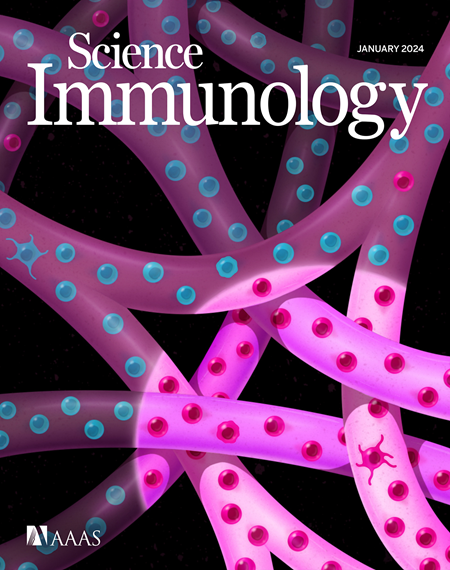Human naïve B cells recognize prepandemic influenza virus hemagglutinins
IF 17.6
1区 医学
Q1 IMMUNOLOGY
引用次数: 0
Abstract
Understanding the naïve B cell repertoire and its specificity for potential zoonotic threats, such as the highly pathogenic avian influenza (HPAI) H5Nx viruses, may allow prediction of infection- or vaccine-specific responses. However, this naïve repertoire and the possibility to respond to emerging, prepandemic viruses are largely undetermined. Here, we profiled naïve B cell reactivity against a prototypical HPAI H5 hemagglutinin (HA), the major target of antibody responses. We found that the frequency of H5-specific human naïve B cells targeting the HA “head” domain was increased relative to cross-reactive B cells to a circulating seasonal H1N1 strain. We classified the isolated monoclonal antibodies (mAbs) by the HA epitopes engaged and found that selected mAbs neutralized H5N1 at germline. We determined a cryo–electron microscopic structure of one mAb in complex with H5 HA to define its epitope. Our study defines the naïve human B cell repertoire recognizing a potentially zoonotic HPAI.

人naïve B细胞识别流感大流行前病毒血凝素
了解naïve B细胞库及其对潜在人畜共患威胁(如高致病性禽流感(HPAI) H5Nx病毒)的特异性,可能有助于预测感染或疫苗特异性反应。然而,这种naïve储备和应对新出现的大流行前病毒的可能性在很大程度上是不确定的。在这里,我们分析了naïve B细胞对典型HPAI H5血凝素(HA)的反应性,HA是抗体反应的主要目标。我们发现h5特异性的人naïve B细胞靶向HA“头部”结构域的频率相对于交叉反应的B细胞对季节性H1N1流感病毒株的频率增加。我们根据参与的HA表位对分离的单克隆抗体(mab)进行分类,发现所选单克隆抗体在种系中和H5N1。我们确定了一个单抗与H5 HA复合物的低温电镜结构,以确定其表位。我们的研究定义了naïve人类B细胞库识别潜在的人畜共患高致病性禽流感。
本文章由计算机程序翻译,如有差异,请以英文原文为准。
求助全文
约1分钟内获得全文
求助全文
来源期刊

Science Immunology
Immunology and Microbiology-Immunology
CiteScore
32.90
自引率
2.00%
发文量
183
期刊介绍:
Science Immunology is a peer-reviewed journal that publishes original research articles in the field of immunology. The journal encourages the submission of research findings from all areas of immunology, including studies on innate and adaptive immunity, immune cell development and differentiation, immunogenomics, systems immunology, structural immunology, antigen presentation, immunometabolism, and mucosal immunology. Additionally, the journal covers research on immune contributions to health and disease, such as host defense, inflammation, cancer immunology, autoimmunity, allergy, transplantation, and immunodeficiency. Science Immunology maintains the same high-quality standard as other journals in the Science family and aims to facilitate understanding of the immune system by showcasing innovative advances in immunology research from all organisms and model systems, including humans.
 求助内容:
求助内容: 应助结果提醒方式:
应助结果提醒方式:


